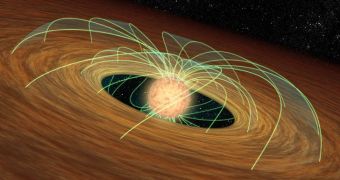One of the most interesting conundrums in astronomy is related to why stars don't fly apart at high speeds while they form. Theoretically, when they first condense from molecular hydrogen, they should be spinning out of control, and yet they don't. A new study analyzes the potential explanations.
Experts have been trying to figure out this mystery for years, and they have already proposed several explanations, some of which have more odds of actually turning out to be true than others.
From our current understanding of stellar formation, these objects emerge from collapsing hydrogen clouds, inside certain types of nebulae called stellar nurseries. As gravity forces the clouds to collapse, the massive friction ignites the gas, and jump-starts nuclear fusion.
The emerging protostar should theoretically spin extremely fast, yet not even the youngest stars astronomers were able to observe thus far appeared to do so. The logical conclusion is that something must be breaking the stars' rotation, preventing them from ripping themselves apart.
One possible explanation for this could be that the object's emerging magnetic field is interacting heavily with the protoplanetary disk around it. The latter is a ring of matter from the previous cloud, that did not collapse into the star.
All of the planets, moons, asteroids, comets and other space debris in our solar system were formed from such an accretion disk around our own Sun. However, after the star formed, the disk was a continuous lump of matter swirling around its outer edge in the inner solar system.
Over the years, direct observations were combined with statistical simulations, allowing astronomers to test whether protoplanetary disks were indeed responsible for slowing down their stars. It was found that stars without these disk tended to spin faster than those that had one.
But the work did not solve the main mystery. If stars without these disks were still spinning at lower speeds than theory predicted, then another process might be at work as well, Universe Today reports.
Adding to the mystery was the fact that there seemed to be no distinction in rotation speed between low-mass stars with or without protoplanetary disks. The difference was mostly notable in high-mass stars, several times heavier than the Sun.
This led experts to propose that a star's own stellar winds were in fact responsible for interacting with its magnetic fields to such an extent that the overall rotation speed decreased enough to allow the object to survive its formation.
At this point, investigators are continuing their research, trying to determine which of these two processes is most prevalent. They also want to know whether these ratios of influences hold steady across stars of various masses or not.

 14 DAY TRIAL //
14 DAY TRIAL //